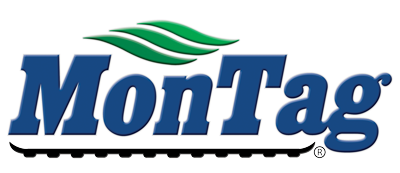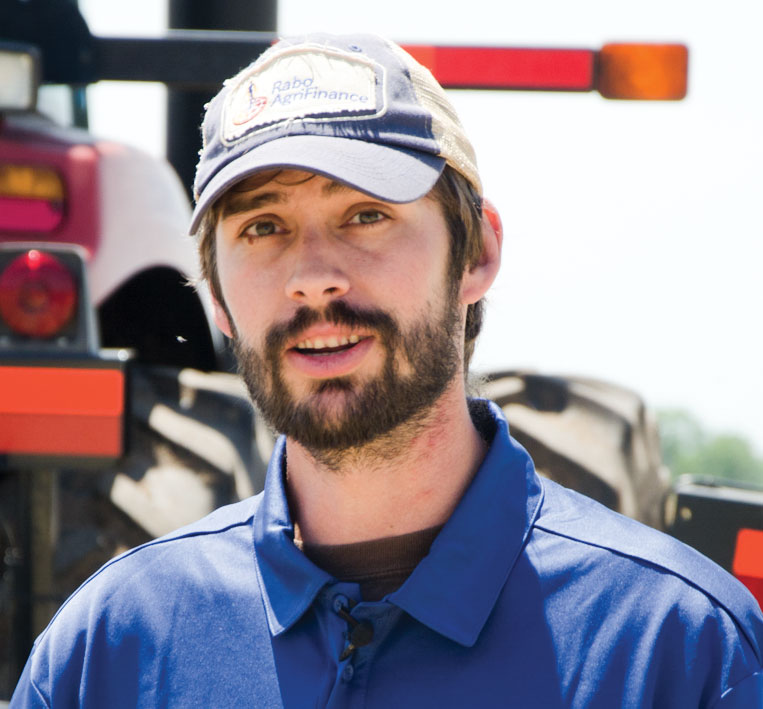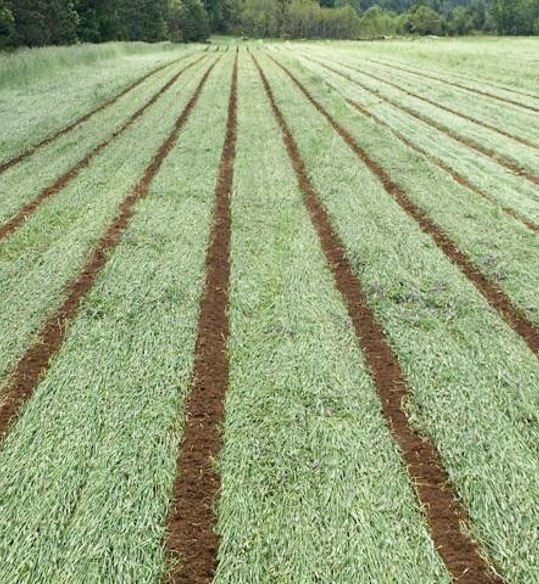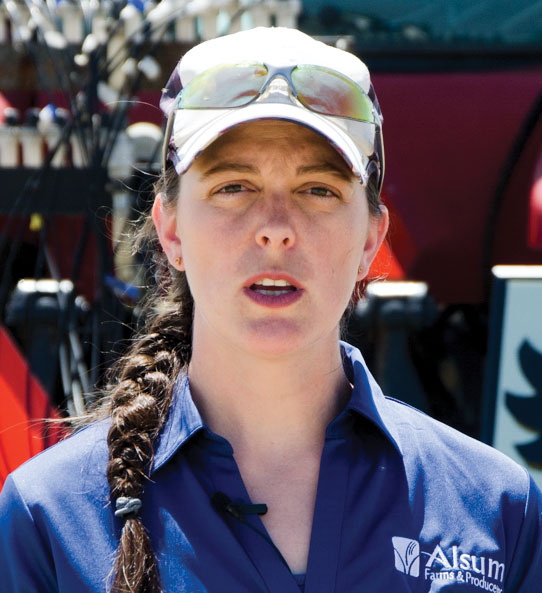Pictured Above: INNOVATIVE THINKERS. Strip-tilling full-time for almost a decade, Megan and Eric Wallendal have applied both science and skill to their ever-evolving system to include calculating precision farming payback, cover crop trials and managing high-value crops.

The phrase “change is constant” is an appropriate one to summarize the ever-evolving strip-till operation that Megan Wallendal and her husband, Eric, manage at Alsum Farms, in Grand Marsh, Wis.
Through innovative experimentation, calculated risk-taking and a willingness to share both the successes and failures, the Wallendals view their strip-till system as an evolving laboratory rather than a stagnant cropping operation.
After nearly a decade of strip-tilling a variety of crops full-time, the third generation farmers still view their system as a work-in progress, but a progressive one for which they are recognized as the Strip-Till Farmer 2020 Strip-Till Innovators.
Farming in primarily sandy topsoil with heavy clay underneath, preserving water and fertilizer has long been a challenge for the Wallendals. With static organic matter content between 0.7-1% they adopted strip-till and other practices to help preserve soil health and increase crop yields.
“With our low water-holding capacity soils, full tillage was always detrimental to our soil health,” Eric says. “We knew there had to be a better way to retain moisture and utilize crop residue and still prepare a proper seedbed to get crops established.”
The 2020 Strip-Till Innovator program is supported by Montag Mfg.

Eric’s dad, John, began first experimenting with strip-till in 1985 and the practice was broadly implemented in 2012 on about 3,200 acres. The operation at the time included a diverse rotation of forage corn, snap beans, soybeans, peas and alfalfa.
They also grew forage corn for a sizeable dairy operation and rented out about 800 acres for potatoes.
Megan says they consider themselves “guerilla farmers” because they have partnered with canning companies to grow their crop of choice any given season.
“We grow whatever makes sense for us and our partners, and that requires a great deal of flexibility on our part,” she says. “With six or seven crops in the rotation it’s a little unconventional, but strip-till allows us to experiment with that diversity.”

“There are times in soybean trials that we’ve actually picked up a bushel or two. However, our cost is $12 per acre, and unless we have $14 or $16 soybeans, it’s not worth doing that new practice…” – Eric Wallendal
Put to the Test
Forage corn and soybeans were the first crops the Wallendals strip-tilled with regularity and Megan recalls the motivation for making the move into strip-till with those crops first.
“In our forage corn, specifically, instead of having two full tillage passes, we would try and make one after a manure application and then prepare the seedbed for the corn,” she says. “So then we wanted to eliminate that first full tillage pass and then we looked at the nutrient application strategy with our strip-till pass, banding fertilizer 4- and 8 inches deep.”
Initially, the Wallendals ran two 12-row Orthman 1tRIPr units; one on 30-inch spacings for soybeans and snap beans and the other set at 22 inches for forage corn. They offset the row units 11 inches on the 12-row unit using John Deere’s RTK network and GreenStar 3 system on their Case IH tractor.
Eric admits the 22-inch system was a bit unusual for corn, but they saw positive results. “We felt we were able to localize nutrients better with a banded placement of fertilizer in the root zone, while not overcrowding the plants,” he says. “We were averaging 250-270 bushels per acre for forage corn, applying about 260 units of nitrogen per acre.”
For forage corn, they typically band a starter fertilizer blend of potassium (K), phosphorus (P), boron and sulfur 4 inches deep with the strip-till rig. At V3 they broadcast apply 100 pounds per acre of ammonium sulfate (AMS) and fertigate another 60 pounds per acre of nitrogen (N) at V8 or V10.
They also experimented with splitting the final application of N between V10 and R3, a couple of weeks before harvest. They tested a dual application of fertilizer with the strip-till rig banding a starter package both 4 inches deep and again at 8 inches, with the thought that the second layer of nutrients will supplement the V3 application.

ROLLED STRIPS. After rolling their cereal rye cover crop, the Wallendals then build spring strips with their 12-row Orthman 1tRIPr. “We go in and strip-till when the rye is about 4 inches high,” Megan Wallendal says. “When it gets to 8-12 inches, we’ll strip it again. Then after we roller-crimp it, we’ll strip-till one more time. That’s early June though, so it is a later system, but we’re starting to do this with our soybeans as well because the weed control is so amazing.”
“This gave us a little more wiggle room with timing of that broadcast application and gave our roots an extra boost of nutrients at that 8-inch depth,” Eric says. “We try to maintain a 1:1 ratio of N we apply vs. what we take off, but we know we can’t bank nitrogen year to year. So we’ve got to manage our applications and still grow a high-yielding crop without degrading the ground.”
To take the guesswork out of in-season N applications, the Wallendals began using sets of 12-inch vertical sensing probes to measure soil moisture, electrical conductivity and temperature. The probes take sensor readings every 4 inches, up to 48 inches deep.
The in-field sensors have become an input management tool the Wallendals use to better time nutrient application and measure plant uptake within their strip-till system.
“We need to know what our soils can hold,” Megan says. “We’re trying to ‘smart apply’ and if our heavier soils can only hold 20-30 units of N, we’re not going to apply 120. We’ll apply 20 or 30 at a time, see when the roots take up those nutrients instead of guessing, and based on crop stage, make that next applicationwhen needed.”
They didn’t offset the row units for soybeans or snap beans, but going into corn residue they’ve had to use a Turbo-Till vertical-tillage tool from Great Plains Mfg. to clear debris off the row ahead of planting with their John Deere 1760 18-row planter.
The Wallendals strip-tilled snap beans off and on for more than 10 years, and saw good success combining strip-till with up to 35 different high-value vegetable crops.
“Snap beans are a 55-day crop, so with strip-till we’re able to help those roots develop a little deeper and more easily access nutrients in a shorter amount of time,” Eric says. “We had one of the canning company’s representatives in the field one year and he said the stands looked perfect.”
Wallendal also sees more consistency with the color and emergence timing of snap beans, compared to conventional tillage practices. “It can be a risky crop, but strip-till has probably added at least a ½-ton-per-acre yield bump for us,” he says.
Data-Driven Decisions
While Eric grew up on the family farm, Megan brought a different dynamic to the operation with a background in research science and a master’s degree in neuroscience. The combination of on-farm experience and scientific curiosity allowed the Wallendals to challenge even their own expectations with testing and trials, using Veris carts and soil moisture probes to record organic matter, pH levels and water-holding capacity in their soils.
Historically, the farm’s topsoil depth has been about 1 foot, but through strip-till they’ve been able to increase that depth to nearly 2 feet. “Even if we see an increase of 0.1% or 0.2% of organic matter, having that extra foot of topsoil allows us to catch and retain more nutrients, so that’s been huge for us,” Megan says.
Some economic returns the Wallendals have seen with soil sensing technology include getting a more accurate reading of rooting depth throughout the growing season. This allows them to understand how full the soil profile is, whether it’s 50% or it’s at wilt and then determining how much water application is needed to saturate the profile.
They’ve also changed from grid sampling to zone sampling to create different kinds of management zones, reduce costs and accumulate more precise data sets.

“A lot of farmers want to know what we’re doing with our Veris maps and setting up management zones based on those zones. When I tell them we’re saving about $10 per acre on a 100 acre field, they get really interested…” – Megan Wallendal
“We started doing zone sampling, and then we actually moved to composite zone sampling,” Megan says. Rather than sending multiple samples to the laboratory to be tested, they’re able to send just one sample that comes from a composite of zones.
Analysis of that sample data allows Megan to write variable-rate fertilizer prescriptions, which has allowed them to save upward of $1,000 per field in variable-rate applied potash.
“It cost us $5 per acre to get our field maps, so the investment has paid for itself,” Megan says. “A lot of farmers want to know what we’re doing with our Veris maps and setting up management zones based on those zones and when I tell them we’re saving about $10 per acre on a 100 acre field, they get really interested.”
The Wallendals have been able to go to every other year soil sampling, or even every year, rather than every 3 years of the grid sample. Thanks to the switch to composite zone sampling in their strip-till system, not only have Megan and Eric been able to test their soil more frequently, but they’ve also been able to better tailor the work they do in each of their fields.
“If we look at it as a management zone, each field has a different target yield,” Eric says. “We have different inputs that you’re going to apply to either maximize the yield or minimize the inputs, if we know that’s a low-yielding area.”
Replication vs. the Norm
However, Eric emphasizes that they generally don’t fully make the shift to new farming practices without first testing them against their standard practices.
“There are a couple crops that we always use the control,” he says. “We use a new practice and we use a standard practice that we’ve done. We look at different kinds of yields, along with costs that we’ve put into trials.”
It’s important to Eric and Megan that they use a large sample size so as to ensure relevance.
“We need to do enough replications to make sure that we’re actually measuring what we’re trying to measure,” Eric says. “We’ve been able to figure out at a micro level what each practice has done over multiple years and multiple fields and replications. We can figure out that our ROI is positive and put a dollar to the different practice that we’re doing, whether it’s $3 an acre or $25.”
For example, Megan emphasizes the importance of sample size when analyzing harvest monitor data. “It can’t be just two rows, or even a single pass,” she says. “It needs to be at least three passes of a combine head, not just our planter head, to be able to get the right data size,” she says.
“We use the SMS software platform on the farm and get a good data set. We try and avoid the headlands and the corners and get somewhere in the middle of the field.”
The Wallendals evaluate costs relative to yield gains for their field trials — and always maintain a control — to make a determination on whether a larger scale adoption of an application, technology or practice is economic.
Specialty Crop Strip-Till: From Hemp to Pumpkins
Always interested in calculated experimentation on their 1,800-acre operation, Megan and Eric Wallendal strip-tilled 50-100 acres of hemp in 2020. After researching market potential and purchasing partners, Megan says they have a game plan for adding the specialty crop to their diverse rotation.
“We have a contract in place and we plan to spring seed a heavy mix of oats and clover on our ground going to hemp,” she says. “We’ll then mow that cover and strip-till into it twice with our 12-row strip-till rig, set up on 22 inches and then transplant right into those strips, which are set up in 5½-foot rows.”
The model for the Wallendal’s hemp system is based off their strip-tilled pumpkin program. They raise about 250 acres of pumpkins, traditionally following either potatoes or maybe corn.
“The fall before we plant pumpkins, we’ll seed about 2½ bushels per acre of Aroostook or Elbon rye, which we’ll fertilizer and water if needed,” Megan says. “We’ll use a dessicant if we have to, to force the cover crop into anthesis and in May, when it’s about 12 inches tall, we’ll strip-till into that rye crop.”
When it’s about knee or hip height, the Wallendals make another strip-till pass, then roller-crimp and follow with one more strip-till pass. “The reason we strip-till three times is because we seed such a heavy cover of rye and we need to break up those root balls and pumpkins need a really specific seedbed.” Megan says.
“We’ve tried just strip-tilling only twice and using a lighter rye, but had trouble getting through after roller-crimping and have found that this pass was like butter through the field.
“We’ll plant our pumpkins in early June, and the only herbicide we’re allowed to apply is a pre-emerge. But we’re only getting about 2% weed pressure in 4-foot rows, so that’s pretty good.”
“There are times in soybeans trials that we’ve actually picked up a bushel or two,” he says. “However, our cost is $12 per acre, and unless we have $14 or $16 soybeans, which we haven’t seen for a little while, even though we’re getting increased yields, it’s not worth doing that new practice.
“However, there’s other times that we’re either decreasing cost, decreasing inputs or increasing yield without increasing cost or inputs enough that the ROI is always positive.”
They recall one instance where they applied a pop-up fertilizer at-plant in conventional forage corn and ended up having 15-20 acres where the product wasn’t applied. There ended up being a 6-bushel per acre difference in yield which equated to a $3 dollar difference per acre in costs, but a $15 dollar per acre difference in ROI.
“We saw about $22 per acre ROI by using the pop-up product,” Eric says. “It’s good to check our best practices to make sure they are still relevant because even small changes can have a big impact on the bottom line.”
Organic Opportunity
While they still grow plenty of conventional crops, the Wallendals also test drove the weed control benefits and targeted fertilizer applications of strip-till in organic production. They transitioned nearly 700 acres to organic strip-till, but acknowledge that the shift comes with inherent costs — especially when it comes to inputs.
Megan says the increased control over fertilizer placement in a strip-tilled system is especially important as those costs rise. “Strip-till has been really important to us for organics, particularly, in terms of banding nutrients,” she says. “We’ve got crops that can’t always reach out for that 2-by-2-inch method. Banding becomes a lot more economical than broadcasting.”
Because all the inputs must be OMRI (Organic Materials Review Institute) approved, the Wallendals’ products are limited organic fertilizers like manure, fishmeal, compost and chicken litter.
“We band these about two gallons per acre,” she says. “The broadcast rates for those are about 10 gallons per acre. That’s a $56 per acre savings on just organic nutrients.”
Increasing demand is likely to help the market for organic crops continue to outpace the added costs it brings to the operation, Megan speculates.
“Our costs might increase 30-50% in some places, but our revenue is much higher,” she says. “Looking at organic markets today, I believe there’s around a 15-20% increase in demand, but the amount of land being transitioned in 2018 was only about 6% of that. That’s a huge gap, one that I think will be around for the next 10 years because it takes three full years to make that transition.”
Wallendal says the biggest issue with strip-tilled certified organic crops is weed pressure. Because of the challenges created by herbicide restrictions on organics, they’ve had to get creative to choke out weeds naturally. For this purpose, they use a roller-crimper, leaving heavy residue in rows.
Specifically, for crops that need a heavy “mat” like pumpkins, Wallendal uses an Aroostook rye variety from Maine as a cover crop. The variety goes through anthesis (pollen shed) about 10 days before a typical cereal rye in Wisconsin would, so she’s able to use a roller-crimper on it sooner.
“We go in and strip-till when it’s about 4 inches high,” Megan says. “When it gets to 8-12 inches, we’ll strip it again. Then after we roller-crimp it, we’ll strip-till one more time. That’s early June though, so it is a later system, but we’re starting to do this with our soybeans as well because the weed control is so amazing. We’re finding 1-2% weed occurrence.”
Though strip-tilling into the cover crop 3 times felt like a lot, a brief experiment with only 2 passes in 2017 and 2018 convinced the Wallendals that all 3 passes were necessary to properly prepare the seedbed.
Purposely treating cover crops themselves like a cash crop has gone a long way toward helping them “crimp nicely,” Megan says.
“In fall, we water the cereal rye and in the spring we’ll give it a shower of nutrients and more water,” she added. “We’ll apply a little 32% N through the center pivot irrigator and spread some Calsol on it as well.”
Leaving heavy residue in rows has also been helpful to choke out weeds.
“Leaving the residue in the row really helps. We have to use a tine harrow a lot in our soybeans, corn and dry beans, so we’re planting a higher population,” she says.
Even small improvements to their weeding program on organic acres pay dividends.
“Once the crops are a little bigger, we can’t use a tine harrow, so we have a finger weeder that’s able to get right near the plant,” Megan says. “It’s been really helpful because we still have to budget hand weeding into our costs of production.
“That usually ends up being about $150 per acre in our organic crops. We haven’t reached that every year, and that’s due to a lot of the cultivation practices we’re using to reduce costs.”







